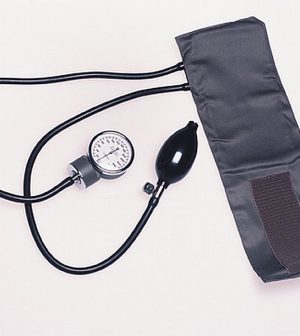- Navigating Your Midlife Crisis: Embracing New Possibilities
- City Raccoons Showing Signs of Domestication
- Mapping the Exposome: Science Broadens Focus to Environmental Disease Triggers
- One Week Less on Social Media Linked to Better Mental Health
- Your Brain Changes in Stages as You Age, Study Finds
- Some Suicide Victims Show No Typical Warning Signs, Study Finds
- ByHeart Formula Faces Lawsuits After Babies Sickened With Botulism
- Switch to Vegan Diet Could Cut Your Greenhouse Gas Emissions in Half
- Regular Bedtime Does Wonders for Blood Pressure
- Dining Alone Could Mean Worse Nutrition for Seniors
Running the Numbers on High Blood Pressure

High blood pressure is a risk factor for many serious health threats, such as heart attack and stroke.
The most recent guidelines from the American Heart Association, the American College of Cardiology and other health organizations reflect research findings that lowering the threshold for high blood pressure and starting treatment earlier does a better job of preventing these complications.
The guidelines stem in part from studies funded by the U.S. National Institutes of Health. Results showed increased heart health benefits to having the top, or systolic, number below a reading of 120 mm Hg.
The New Normal: What Your Blood Pressure Reading Means
- Normal blood pressure: Less than 120 and less than 80 mm Hg
- Elevated blood pressure: 120-129 and less than 80 mm Hg
- Hypertension stage 1: 130-139 or 80-89 mm Hg
- Hypertension stage 2: 140 or higher and/or 90 mm Hg or higher
Another key guideline recommends starting treatment when readings reach 130/80 mm Hg rather than the old target of 140/90 mm Hg. For some people, treatment simply means making lifestyle changes with diet and exercise, while others will do better with medication, such as when, for example, they have a higher personal risk for heart disease.
If you have other health conditions like kidney disease or diabetes, it may take more time and effort working with your doctor to find the right balance of medications to bring results with the fewest side effects.
These guidelines reinforce the need to see your doctor regularly and to take your medication as directed. Remember that, on its own, high blood pressure has no symptoms — the only way to know how you’re doing is to measure it at home and at doctor visits.
More information
The American Heart Association has more on blood pressure categories and how to understand them.
Source: HealthDay
Copyright © 2025 HealthDay. All rights reserved.










